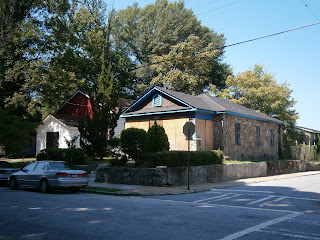Since the last blog post, I began a Heritage Preservation Masters
program at Georgia State and resigned from my position as Program
Director of the Stewart Center in order to do so. Because of my love
for the Stewart Center and the crucial role it played in unearthing my
excitement for history, preservation, and research, I have continued
researching its history as a part of my studies. I could not fathom
abandoning the information and stories I had acquired through my
research over the past few years--I wanted to preserve and share it in a
form that would be accessible to future generations of APSC family.
This
spring when I decided to become a full time student, I talked to my
advisor about taking a "Directed Readings" course--which basically
entails conducting an independent research project as an elective, under
my advisors supervision. After he approved my proposal to write a
comprehensive history of the Stewart Center, I knew that I had the
necessary pressure and supervision to make sure the project became a
reality. While I wont bore you with all the details of the research and
writing I have done this summer--believe me when I say I have been busy
:)
I met with my advisor a few weeks ago to go
over the first draft of the history. While the draft was a start, it
has a long ways to go. As my advisor said and my professor echoed, the
scope of this project is much larger than can be completed this summer.
(100 years is a lot to cover!) I plan to incorporate the project into
several other courses, including my oral history class this fall, and
continue working on it independently.
One of the most
difficult parts of the project, so far, has not been researching or
describing events that occurred at the Center. The difficulty has been
in describing the "heart" of the Stewart Center--the spirit of the place
that has come to be so important to me. In fact, that was my advisors
main critique--that while I had described a lot of people and events, I
had not talked about the Center as its own
being.
A
few days ago, I interviewed one of the current Stewart Center board
members, Esther Grissom. When I asked her about her hopes for the
Center moving forward, one of the things that she hoped for was that the
Center would continue providing the Youth with opportunities for
exposure to the world outside Reynoldstown. I was caught off guard by
the mention of this special group of teenagers, and tears started
streaming down my face. As I struggled to take notes through blurry
eyes, all I could think about was the many quirks and qualities that I
loved in those teenagers, and how important it was to me that they find
happiness and success (however they choose to define it).
I
realized that for me, that feeling, that desire, is the heart of the
Stewart Center....loving and accepting people as they are, championing
one anothers hopes and dreams, and working together to achieve every
individual's definition of "success."





